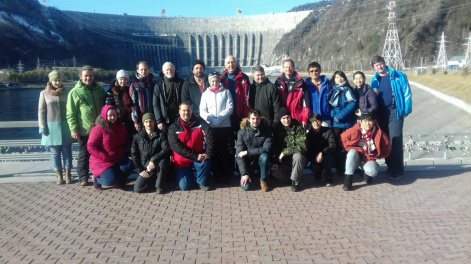The first online seminar on MAX-phases was held in Krasnoyarsk
26 August 2020 г.

The event, which can be considered an important intermediate point of the first year of the mega grant implementation, aims at bringing together scientists from different fields of materials science who are interested in physical properties of MAX materials - nanostructures consisting of three layers: M is a transition metal, A is a group A element (mainly IIIA and IVA of the periodic system), and X is carbon and/or nitrogen. The seminar brought together leading experts in these structures, including invited speakers from Germany, France, USA and Sweden.
Daniel Bürgler from the Peter Grünberg Institute, Germany, devoted his presentation to hybrid molecular magnets and their nanomagnetic characteristics. The scientist commented on the results of his work: “Hybrid molecular magnets are formed during chemisorption - the absorption of substances from the environment, aromatic molecules on ferromagnetic transition metal surfaces. Such hybridization leads to unstable spin orientation of a molecule, i.e. to the energy disequilibrium. Therefore, the atoms associated with the molecule also change their electronic and magnetic orientation. Such a chemisorbed molecule, together with the atoms bound to it, can be considered as a new magnetic entity, the so-called hybrid molecular magnet with an increased coercive force and Curie temperature ”.
One of the most commonly used methods for studying such particles was reported by Anna Semisalova from the University of Duisburg-Essen, Germany. The researcher notes that the spectroscopy method for in-depth investigation of the magnetic properties of nanomaterials is based on detecting a shift in magnetization through microwave absorption measurements. “FMR spectroscopy is the main tool for analyzing the magnetic properties of particles and materials. FMR spectroscopy is a well-known method for studying changes in magnetic anisotropy in thin ferromagnetic films and multilayers, ” explains the scientist.
Christina Birkel, Arizona State University, USA, presented an unusual method for synthesizing MAX materials. The researcher notes that not only haven’t many of the MAX materials been studied, but they haven’t even been produced or found. “Many new phases haven’t been implemented experimentally yet. They are interesting functional materials which are expected to exist and need to be studied,” says the physicist.
MAX phases are usually obtained by high-temperature solid-state methods. However, these methods may not be enough to detect other MAX systems. Our team uses creative wet chemical synthesis methods and unconventional solid-state syntheses to obtain targeted MAX phases. Using such methods, scientists have succeeded in creating an aluminum-vanadium carbide phase. “We use various unconventional methods, including synthesis using microwave heating, and reactions with liquid ammonia. In addition to providing access to new or poorly studied MAX phases, wet chemistry methods expand the microstructural space of bulk MAX phases and lead, for example, to anisotropic particles. The latter is especially interesting because it allows synthesizing nitride MAX-phases, ” says Christina Birkel.
Krasnoyarsk researchers also shared the results of their developments. A team of scientists from the L.V. Kirensky Institute of Physics SB RAS presented a recently created magnetic MAX material in the form of a heteroepitaxial thin film on a magnesium oxide substrate. “The material was predicted theoretically and later synthesized. The resulting structure is an excellent model system for studying complex magnetic phenomena occurring in atomic layer materials. This sample exhibits ferromagnetic properties at room temperature. This is due to the change in the crystal structure of the layers and residual magnetization of the object in weak fields, ” explains Sergei Lyashchenko, Candidate of Physical and Mathematical Sciences, researcher at the L.V. Kirensky Institute of Physics SB RAS.
Anna Lukyanenko, junior researcher at the Institute of Physics described methods of forming sub- and nanoscale magnetic thin materials: “We have considered methods of micro- and nanoscale surface modifications which are used to obtain MAX-structures. Many of them are formed by lithography and chemical etching. Photolithography can be used to create a continuous film device or masks through which material is deposited onto substrates. Wet chemical etching is used to obtain MXenes from MAX phases. MXenes is a family of transition metal carbides, carbonitrides and nitrides. They are named MXenes because the vast majority of them were obtained by etching aluminum layers from the MAX phases, ” explains the scientist. The thinnest materials are films. According to the researchers, there are two main methods for synthesizing such materials. The first, using chemical vapor deposition, allows the production of high quality films on a variety of substrates. The second is based on the delamination of layered solids.
The participants of the seminar note that magnetic MAX materials are of great technological importance. Such material classes can be used, for example, to create massive permanent magnets used in electric vehicle motors, wind turbines, and magnetic cooling devices.
Share:
